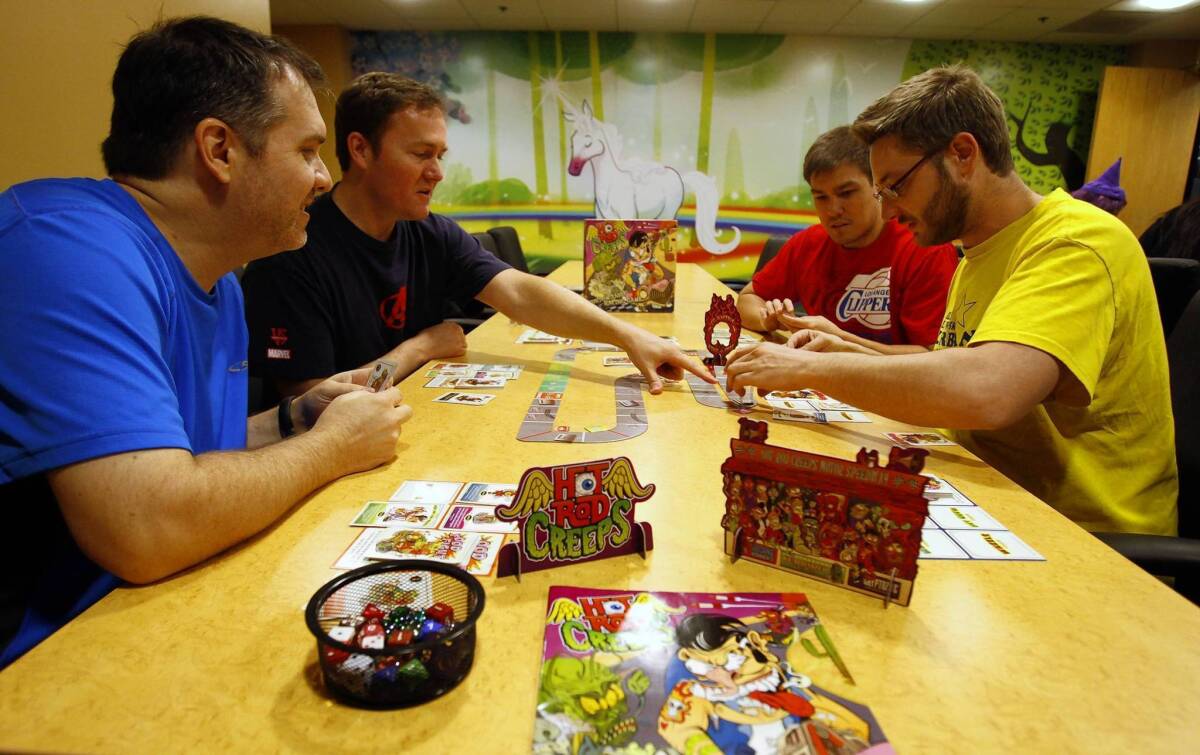Board games are growing in popularity again

- Share via
Blockbuster board games are unusual, but Days of Wonder has one in its Ticket to Ride.
The already-classic cardboard game, in which players strategize over how to build the best railway routes, was released in 2004 and has worldwide sales of “several hundred thousand units per year,” said Eric Hautemont, co-founder of the Los Altos, Calif., game company.
That places it in the forefront of a blossoming independent game world, in which new titles such as monster bonanza King of Tokyo and kingdom-building game Dominion are fighting to join traditional classics such as Monopoly and Sorry.
PHOTOS: Video games-to-film adaptations
Driven by online word of mouth on board game websites such as BoardGameGeek and by the popularity of online digital games, including Days of Wonder’s Small World, old-fashioned board games have acquired cult status and are growing in popularity.
The American board game thriller Pandemic and imports such as Carcassone and the Settlers of Catan are the titles most often cited as having fueled the table-top renaissance. They have been followed by hits such as the celebration of misery game Gloom, the civilization epic 7 Wonders and the galactic adventure Race for the Galaxy.
Days of Wonder’s Hautemont estimated 900 games are released annually by about 40 active publishers, designed for a small but enthusiastic audience.
PHOTOS: Hollywood backlot moments
Russell Howell, 42, discovered the independent board game scene about five years ago, and today he maintains the LA Games group, which organizes gaming events at stores and coffeeshops around L.A.
“I found that designer board gaming held much of what I was looking for in a form of entertainment that video games quite often lacked: a personal connection,” Howell said.
Designing and releasing a game is not cheap. Hautemont said Days of Wonder spends about $20,000 simply to develop a game. That’s at the high end, but Hautemont’s company grossed $7 million the year Ticket to Ride was released.
PHOTOS: Video game cameos in ‘Wreck-It Ralph’
Most game publishers have more modest budgets. Journalist-turned-game designer/publisher Chris Kirkman budgeted $18,000 to $20,000 to develop, print and publish Carnival, his first game.
Matt Leacock, chief designer at social communications firm Sococo, once attempted to self-release the racing game Lunatix Loop. He unveiled Loop at the international gaming convention Spiel, held in Essen, Germany, which attracts more than 100,000 people.
“Each game probably cost me about $10, maybe $15,” Leacock said. “I sold them for $25. That didn’t cover all the incidentals, like the costs of booths and import taxes.”
Leacock lost money and said, “I wouldn’t encourage anyone to go that route. If you don’t know what you’re doing, you’re just flooding the market with more bad product.”
As a result, most who design or publish independent board games have supplemental incomes. Alf Seegert is a lecturer at the University of Utah, and last year he released the Road to Canterbury, a game inspired by Geoffrey Chaucer’s “The Canterbury Tales,” via Gryphon Games. Nathan McNair consults in finance compliance, and his Pandasaurus Games has specialized in re-releasing out-of-print or hard-to-find games such as Tammany Hall.
“The majority of board game designers do this as a hobby,” Kirkman said. “It’s hard for us as a publisher to make a living.”
Hollywood may help. Cryptozoic Entertainment Inc. in Irvine has acquired licenses to make games of hit TV shows like “The Walking Dead” and “The Big Bang Theory,” and now will produce games based on the upcoming trilogy of “Hobbit” films from director Peter Jackson.
The digital world has also helped. Online versions have fueled a growing appetite for the table-top games — in part because they are priced much lower. A board game that costs $50, such as Ticket to Ride, might have an Xbox version that sells for as little as $4.99.
“The video game industry has been a boon to board games,” said Rick Soued, who oversees Gryphon Games and Eagle Games and founded online game retailer Funagain Games. “There’s a generation or two now who have become aware of board games via video games.”
Pandasaurus’ McNair is one of them. He was an online gamer who sampled the Setters of Catan on an Xbox. He found playing the physical game more satisfying.
“I think we’ve all been burned out by the digital age,” he said. “I like video games still, and I’m on my cellphone constantly, but I think people are looking for a way to hang out with friends and have a more social experience.”
The low prices raised some eyebrows at game shops. Said Hautemont, “That was one of the questions initially from retailers. ‘Wait, you’re going to do online games and sell them for how much? That’s going to cannibalize my sales.’ No, guys, that’s going to increase your sales.”
In fact, board games are the top-selling sector at Pasadena’s Game Empire, where board game sales sometimes jump 40% after the release of an iPad or iPhone edition.
“It’s like playing chess versus the computer,” said Game Empire owner Chuck Robbins. “What happens is you get introduced into the game. The advent of these kind of games has improved … the sales of the actual hard copies.”
Designers and publishers agree the board game sector is growing but cannot say with certainty how much or how fast. The top-selling games on sites such as Amazon.com and Funagain are largely the usual suspects — fantasy card game Magic and standbys such as Jenga. The trade group Game Manufacturers Assn. said it does not release data on top-selling games.
Even for successful games, the margins are punishing, and small publishers endure a constant juggling act.
“The economies of the scale of printing won’t let you do any less than 2,000 [copies], but you stick your neck out pretty far if you do more than 5,000,” Soued said “There’s certainly a lot of designers and self-publishers who do 20,000 copies. It’s the rare game that sells 20,000 copies.”
Pandasaurus printed about 4,000 copies of Tamanny Hall at a cost of $12 each, McNair said, adding, “That doesn’t include paying the designer, the artist, shipping and a lot of other small costs.”
All this makes working in board games “the best and worst business in the world,” Hautemont said.
“It’s like the book publishing business,” he said. “If you have the next ‘Harry Potter,’ you call your printer and say, ‘Please, start printing me more money.’ If you don’t have the next ‘Harry Potter,’ you live book to book.”
MORE:
INTERACTIVE: TVs highest paid stars
PHOTOS: Hollywood back lot moments
More to Read
From the Oscars to the Emmys.
Get the Envelope newsletter for exclusive awards season coverage, behind-the-scenes stories from the Envelope podcast and columnist Glenn Whipp’s must-read analysis.
You may occasionally receive promotional content from the Los Angeles Times.











